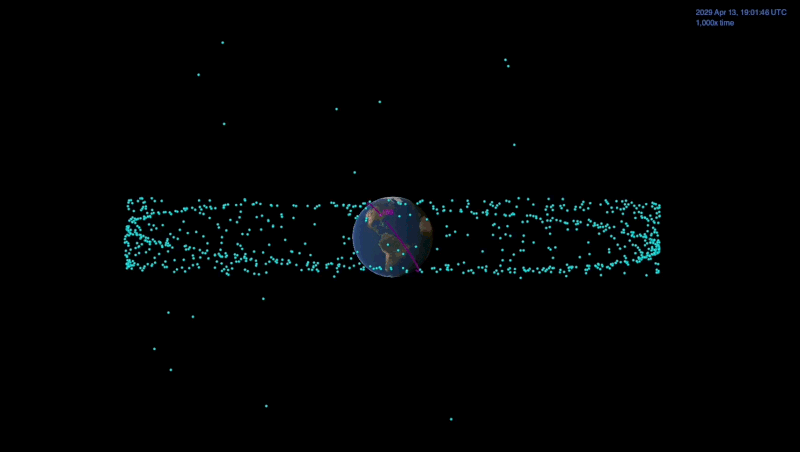Gyanmandu:
The colossal asteroid, which named after the Egyptian god of chaos and destruction, is expected to approach the Earth quiet close on April 13, 2029, according to the latest data from NASA. An Asteroid measuring more than 1,115ft (340m) across will near-miss the Earth. According to the US space agency, it is incredibly rare for asteroids of this size to shoot past our planet this close.
The colossal asteroid will skim the Earth from a height at which many of the planet’s spacecraft operate. Asteroid Apophis will swing by from a distance of about 19,000 miles (31,000 km) above the surface. And when the asteroid approaches, it will be visible to the naked eye as a speck of light gradually “getting brighter and faster”. At it’s brightest, the asteroid will light up to the same magnitude as the Little Dipper or Ursa Minor in the northern skies. The Scientists refer this to be an excellent opportunity to observe the asteroid with both optical and radar telescopes. Scientists might be able to see surface details that are only a few meters in size through the radar observations.
But there is no reason to panic just yet because Apophis is expected to pass the Earth without the risk of striking. Asteroid Apophis was first discovered in 2004 by astronomers at the Kitt Peak National Observatory in Arizona, US.
NASA explained the asteroid, looking like a moving star-like point of light, will first become visible to the naked eye in the night sky over the southern hemisphere, flying above Earth from the east coast to the west coast of Australia. It will be mid-morning on the East Coast of the United States when Apophis is above Australia. t will then cross the Indian Ocean, and by the afternoon in the eastern US it will have crossed the equator, still moving west, above Africa. Apophis will make its closest approach of the Earth around 11pm BST or 6pm Eastern Time over the Atlantic Ocean. The asteroid will shoot by so fast, NASA expects it cross the ocean in just one hour. By around midnight to 7pm EDT, the space rock will cross the United States. About 2 billion people will gaze upon the passing of the asteroid since is a rare phenomenon.
Although scientists are positive Apophis won't hit Earth in 2029, they can't yet rule out possible collisions many decades in the future, and there are plenty of other large space rocks orbiting the sun in Earth's neighborhood. Experts in planetary defense track these objects and prepare techniques that could divert any that do pose a threat. Asteroid scientists and planetary defense experts have already begun that work, with a series of presentations highlighting topics they'd like to consider between now and the 2029 Apophis flyby.
NASA explained the asteroid, looking like a moving star-like point of light, will first become visible to the naked eye in the night sky over the southern hemisphere, flying above Earth from the east coast to the west coast of Australia. It will be mid-morning on the East Coast of the United States when Apophis is above Australia. t will then cross the Indian Ocean, and by the afternoon in the eastern US it will have crossed the equator, still moving west, above Africa. Apophis will make its closest approach of the Earth around 11pm BST or 6pm Eastern Time over the Atlantic Ocean. The asteroid will shoot by so fast, NASA expects it cross the ocean in just one hour. By around midnight to 7pm EDT, the space rock will cross the United States. About 2 billion people will gaze upon the passing of the asteroid since is a rare phenomenon.
Although scientists are positive Apophis won't hit Earth in 2029, they can't yet rule out possible collisions many decades in the future, and there are plenty of other large space rocks orbiting the sun in Earth's neighborhood. Experts in planetary defense track these objects and prepare techniques that could divert any that do pose a threat. Asteroid scientists and planetary defense experts have already begun that work, with a series of presentations highlighting topics they'd like to consider between now and the 2029 Apophis flyby.









































